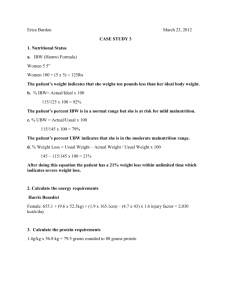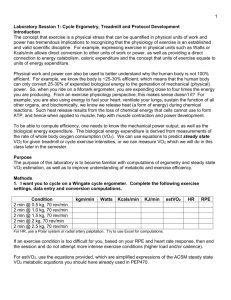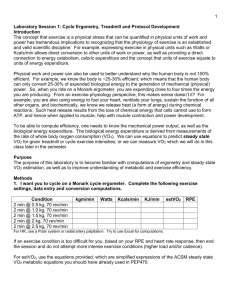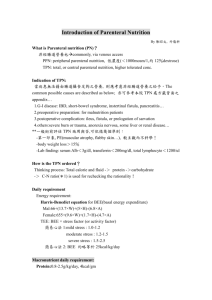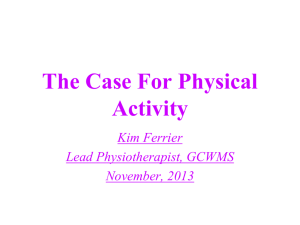TPN origin and calculations
advertisement
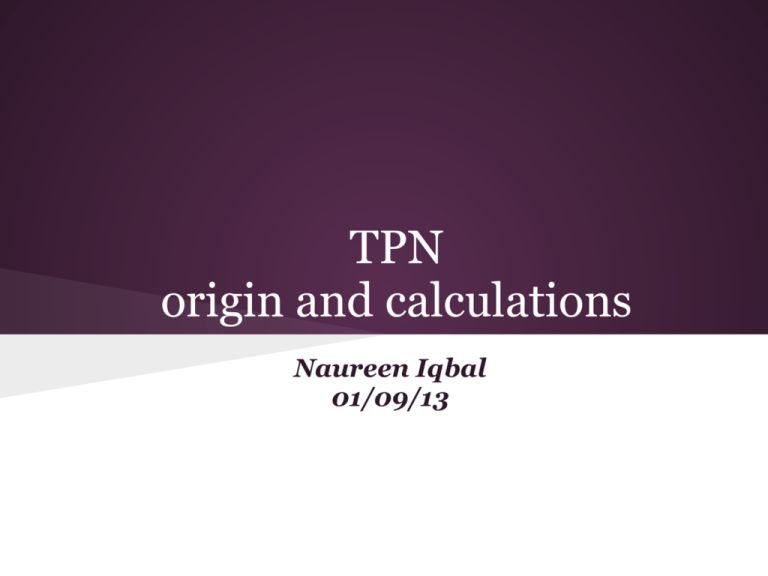
TPN origin and calculations Naureen Iqbal 01/09/13 TPN - History ● Glucose and electrolyte ● Protein hydrolysates in 30s ● Fat emulsion- Intralipid in 60s. ● Vitamins, minerals, trace elements ● Central venous catheter ● Peripheral parenteral nutrition Indications - TPN 1. Documented inability to absorb adequate nutrients via the GI tract: ○ Massive small bowel resection/short bowel syndrome ○ Radiation enteritis ○ Severe diarrhea ○ Untreatable steatorrhea/malabsorption 2. Complete bowel obstruction or intestinal pseudoobstruction 3. Severe catabolism with/without malnutrition when GI tract is not usable within 5-7 days 4. Inability to obtain enteral access to provide sufficient nutrients Indications - TPN 5. Moderate to severe pancreatitis 6. Persistent GI hemorrhage 7. Acute abdomen/ileus 8. Lengthy GI work-up requiring NPO status for several days in a malnourished patient 9. High output enterocutaneous fistula and inability to gain enteral access distal to fistula site 10. Trauma requiring repeat surgical procedures Relative Indications ● ● ● ● ● ● ● ● Enterocutaneous fistula IBD not responding to medical therapy Hyperemesis gravidarum Intractable vomiting Partial small bowel obstruction Intensive chemotherapy/severe mucositis Major surgery/stress when enteral nutrition not expected to resume in 7-10 days Chylous ascites or chylothorax when medium chain triglycerides ± enteral nutrition does not adequately decrease output Peripheral IV Nutrition Indications ● Nutritional needs <1,800 Kcal/day ● IV nutrition requirement <10-14 days ● Peripheral venous access is available ● Requires only one IV ● Fluid restriction is not an issue Contraindications ● Functional GI tract ● Treatment anticipated for <5 days in patients without severe malnutrition ● Inability to obtain venous access ● A prognosis that does not warrant aggressive nutrition support ● When the risks of parenteral nutrition are judged to exceed the potential benefits Access Devices - Peripheral Lines - Short - Midline - Central Lines - PICC - Hickman/Broviac - Groshong Catheter - Femoral line - Multiple lumen acute care catheters - Port Complications ● Related to access device ● Metabolic complications Complications - Access ● Mechanical ○ Hemo/Pneumothorax ○ Arterial puncture ○ air embolism ○ nerve damage ○ thoracic duct damage ○ Hematoma ○ Misplaced catheter ● Thrombotic ● Septic complications ○ ○ ○ When to change the line PIV- 72-96hrs (adults) Midline/CVL- do not replace routinely Metabolic Complications ● ● ● ● ● ● ● ● ● ● ● ● Hyper- or hypo-glycemia Hyperosmolar non-ketotic acidosis Hypertriglyceridemia Fat Overload Syndrome Essential fatty acid deficiency Prerenal azotemia Hyperammonemia Hyperchloremic metabolic acidosis Metabolic alkalosis Hepatic/biliary complications Electrolyte abnormalities Refeeding Syndrome Recommendations Preoperative TPN: ● Only to severely malnourished patients ● 7-10 days pre-op ● expected reduction of post-op complications of 10% Postoperative TPN: ● Routine post op TPN is contraindicated ● Patients who experience complications resulting in inability to tolerate oral diet for ● 7-10 days in previously well nourished patients ● 5-7 days in malnourished patient Calculating Parenteral Feeding - Patient's energy needs (Kcal/day) - Protein/nitrogen need/day - Fluid need/tolerated - Fat emulsion need/tolerated - Dextrose need/concentration - Electrolyte/minerals/vitamin need - Osmolality - Route - TPN soln: 2 in 1, 3 in 1 Calculating Parenteral Feeding ● Formula for calculating TPN: ● http://health.csusb.edu/dchen/368%20stuff/TPN% 20calculation.htm ● Formula to calculate macronutrient content: ● http://clincalc.com/TPN/Macronutrients.aspx ● Formula for calculating osmolatity: ● http://www.rxkinetics.com/tpnosmolcalc.html Energy requirement ● Harris-Benedict + activity +infection/fever factor = Energy (Kcal) ● Scale: ○ ○ ○ ○ Normal need: 25-30 kcal/kg/day Elective surgery: 28-30 kcal/kg/day Severe injury: 30-40 kcal/kg/day Extensive trauma/burn: 45-55 kcal/kg/day Protein requirement ● Protein: 0.83 - 2.5 gm/kg/day (typically: 1.5 gm/kg/day) ● Nitrogen 1 gm = 6.25 gm protein ● Non protein energy (kcal) to nitrogen (N) ratio: ○ 80 kcal: 1 gm N severely stressed condition ○ 100-150 kcal: 1 gm N stressful condition anabolism ○ 250-300 kcal: 1 gm N normal body maintenance ● Prolonged TPN should contain ○ Glutamine ○ Choline Fluid requirement ● 30 – 50 cc fluid/kg ● 100 cc free water/gm N intake + 1cc/kcal intake ● 100 cc/kg for first 10kg ○ + 50 cc/kg for 2nd 10kg ○ + 20 cc/kg for each additional kg Fat requirement ● ● ● ● ● ● Maximal tolerance level of lipids: 2.5 gm/kg body weight av. 30% energy should be from fat 60% of energy from fat is upper limit. Essential fatty acids (EFA) 2-4% Kcal Fat energy: 9 kcal/gm Fat emulsions are made isotonic by adding glycerol Fat emulsions: ○ 10% fat emulsion: 1.1 kcal/cc ○ 20% fat emulsion: 2.0 kcal/cc ○ 30% fat emulsion: 3.0 kcal/cc Carbohydrate requirement ● ● ● ● ● ● ● Main source of fuel Min. need/ day : 100gm Max. rate: 5 mg/kg/min (7.2 g/kg/day) Max. CHO we can use : 500 g/day CHO given as dextrose monohydrate Energy: 3.4 kcal/gm Solutions: 50% and 70% Vitamins/minerals ● Include 12 vitamins except Vit K ● Trace elements: iron not routinely added because it changes the pH of the solution Osmolarity ● Dextrose: 5 mOsm/g Protein: 10 mOsm/g Lipid: Negligible ● Vitamins/minerals: 300 - 400 mOsm/L ● Peripheral TPN: <900 mOsm/L Central TPN: 1500 - 2800 mOsm/L ● ● ● A 500ml bottle of 5% amino acid solution provides ------ grams of protein 1- 2.50 g 2- 5.00 g 3- 12.5 g 4- 25.0 g 5- none of the above A 500ml bottle of 5% amino acid solution provides ------ grams of protein 1- 2.50 g 2- 5.00 g 3- 12.5 g 4- 25.0 g 5- none of the above Your patient needs 92g of protein per day. remaining fluid needs are 2000cc/day. What percent AA solution will meet this patient's needs? 1- 2.3% 2- 4.6% 3- 9.2% 4- 18.4% 5- None of the above Your patient needs 92g of protein per day. remaining fluid needs are 2000cc/day. What percent AA solution will meet this patient's needs? 1- 2.3% 2- 4.6% 3- 9.2% 4- 18.4% 5- None of the above What is the maximum lipid tolerance (in grams) for a patient who weighs 70 kg? 1- 125 g 2- 175 g 3- 250 g 4- 370 g 5- None of the above What is the maximum lipid tolerance (in grams) for a patient who weighs 70 kg? 1- 125 g 2- 175 g 3- 250 g 4- 370 g 5- None of the above 1500 ml of D50W provides ----- grams of dextrose and ------ kcals. 1- 500 g; 1700 kcals 2- 500 g; 2000 kcals 3- 750 g; 2550 kcals 4- 750 g; 3000 kcals 5- None of the above 1500 ml of D50W provides ----- grams of dextrose and ------ kcals. 1- 500 g; 1700 kcals 2- 500 g; 2000 kcals 3- 750 g; 2550 kcals 4- 750 g; 3000 kcals 5- None of the above The maximum carbohydrate tolerance for a patient who weighs 70 kg is ----- grams per day (rounded to nearest whole number) 1- 504 g 2- 650 g 3- 703 g 4- 811 g 5- None of the above The maximum carbohydrate tolerance for a patient who weighs 70 kg is ----- grams per day (rounded to nearest whole number) 1- 504 g 2- 650 g 3- 703 g 4- 811 g 5- None of the above 250 mls of a 10% lipid emulsion provides ---- kcals 1- 250 kcals 2- 275 kcals 3- 500 kcals 4- 550 kcals 5- None of the above 250 mls of a 10% lipid emulsion provides ---- kcals 1- 250 kcals 2- 275 kcals 3- 500 kcals 4- 550 kcals 5- None of the above What are the fluid needs of a 75 kg man? (use ml/kg method) 1- 1875 ml/d 2- 2250 ml/d 3- 2625 ml/d 4- 3000 ml/d What are the fluid needs of a 75 kg man? (use ml/kg method) 1- 1875 ml/d 2- 2250 ml/d 3- 2625 ml/d 4- 3000 ml/d A patient receives a 1000 ml bag of TPN which contains 10% dextrose & 7% protein. In addition, this patient receives 250 ml of a 20% fat emulsion. How many calories does this approximately represent? 1- 1020 kcals 2- 1420 kcals 3- 1820 kcals 4- 2220 kcals A patient receives a 1000 ml bag of TPN which contains 10% dextrose & 7% protein. In addition, this patient receives 250 ml of a 20% fat emulsion. How many calories does this approximately represent? 1- 1020 kcals 2- 1420 kcals 3- 1820 kcals 4- 2220 kcals Calculate the protein, kcals, EFA content of the following TPN prescription: 1.0 L D70W; 1.0 L 7% AA; 214 cc 20% lipid/day (50% EFA) 1- 70g protein; 2601 NP kcals/d; NPC:N 235:1; 14% EFA 2- 70g protein; 3228 NP kcals/d; NPC:N 286:1; 12% EFA 3- 70g protein; 2808 NP kcals/d; NPC:N 251:1; 7% EFA 4- 70g protein; 3228 NP kcals/d; NPC:N 286:1; 8% EFA 5- None of the above Calculate the protein, kcals, EFA content of the following TPN prescription: 1.0 L D70W; 1.0 L 7% AA; 214 cc 20% lipid/day (50% EFA) 1- 70g protein; 2601 NP kcals/d; NPC:N 235:1; 14% EFA 2- 70g protein; 3228 NP kcals/d; NPC:N 286:1; 12% EFA 3- 70g protein; 2808 NP kcals/d; NPC:N 251:1; 7% EFA 4- 70g protein; 3228 NP kcals/d; NPC:N 286:1; 8% EFA 5- None of the above and dextrose solutions to be used, along with rate of administration. Provide 30% fat kcals from a 20% lipid emulsion. (rounded to nearest 0.1) Nutrient needs: 2800 kcals; 100 gm protein; 2500cc fluid 1- 3.7% lipid; 23% dextrose; 4% amino acids; 104.2 cc/hr 2- 3.7% lipid; 20% dextrose; 4% amino acids; 104.2 cc/hr 3- 3.7% lipid; 23% dextrose; 8% amino acids; 104.2 cc/hr 4- 8.3% lipid; 23% dextrose; 4% amino acids; 104.2 cc/hr 5- None of the above and dextrose solutions to be used, along with rate of administration. Provide 30% fat kcals from a 20% lipid emulsion. (rounded to nearest 0.1) Nutrient needs: 2800 kcals; 100 gm protein; 2500cc fluid 1- 3.7% lipid; 23% dextrose; 4% amino acids; 104.2 cc/hr 2- 3.7% lipid; 20% dextrose; 4% amino acids; 104.2 cc/hr 3- 3.7% lipid; 23% dextrose; 8% amino acids; 104.2 cc/hr 4- 8.3% lipid; 23% dextrose; 4% amino acids; 104.2 cc/hr 5- None of the above ● ● ● ● ● ● ● ● References Recollections of pioneer in nutrition: Landmark in development of parenteral nutrition. J Am Coll of Nutrition.1992 Aug;11(4):366-73. Perioperative Nutrition support for patients undergoing gastrointestinal surgery: critical analysis and recommendations. World J of Surgery, June 1999, Vol 23, issue 6, p565-569. Appropriate protein provision in critical illness: a systematic and narrative review. Am J Clin Nutr 2012. 96. 591-600. Total parenteral nutrition in the surgical patient: a meta-analysis. Can J Surg 2001, 44:102-11. http://www.medicine.virginia. edu/clinical/departments/medicine/divisions/digestive-health/nutritionsupport-team/nutrition-articles/MadsenArticle.pdf http://health.csusb.edu/dchen/368%20stuff/TPN%20calculation.htm http://www.csun.edu/~cjh78264/parenteral/calculation/index.html http://www.cdc.gov/mmwr/preview/mmwrhtml/rr5110a1.htm
